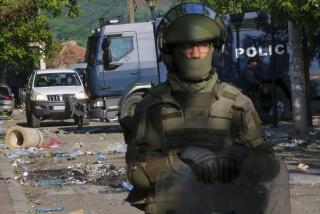Threat of Violence Circles Sarajevo Despite Calm : Bosnia: Mortar blast shatters illusion of peace. Heavy weapons are still being found near city.
- Share via
SARAJEVO, Bosnia-Herzegovina — A mortar blast, a surge in machine-gun fire, a thwarted aid delivery and U.N. discovery of dozens more heavy weapons in Serbian-held territory made clear Wednesday that the siege of Sarajevo has not really ended.
Although the capital remains calm in comparison with the unbridled bombardment of the last 22 months, U.N. officials are finding it more difficult each day to pass off the NATO ultimatum for ending the strangulation of this city as a resounding success.
A mortar that detonated on the city’s eastern outskirts overnight was too close to the confrontation line between Bosnian government and Serbian rebel forces to determine which side had fired it, said Lt. Col. Bill Aikman, spokesman for the U.N. Protection Force (UNPROFOR) in Bosnia-Herzegovina.
U.N. officials have been assuring the international community since NATO’s Monday deadline for surrender or withdrawal of all heavy artillery from a 12-mile zone around Sarajevo that a sophisticated French radar system in place here could precisely locate any weapon firing on the capital in violation of a cease-fire.
But Aikman said the explosion was too distant from the radar system located at the eastern extreme of the city, making it impossible to determine the source and fix a target for retaliation.
U.N. troops likewise claimed that they could not pinpoint the source of heavy artillery fire on a convoy of Swedish peacekeepers near the northeastern city of Tuzla on Tuesday, in which five soldiers were injured.
North Atlantic Treaty Organization flyovers were ordered, but no return fire was authorized by U.N. officials at mission headquarters in Zagreb, Croatia, despite a reported request from the besieged peacekeepers.
Aikman said the source of the fire could not be determined. But the chief of staff of the Nordic battalion that was targeted in the attack, Lt. Col. Alf Gorsjo, told news agency reporters in Tuzla that the fire came from Serbian-held territory.
One of the most telling indications that NATO’s Feb. 9 edict for liberating Sarajevo has evaporated amid U.N. objections to Western military intervention was the refusal by French peacekeepers to allow an aid official to cross the U.N.-patrolled siege line.
The Sarajevo director of the International Rescue Committee, John Fawcett, had obtained the support of the U.N. commander in Bosnia, British Lt. Gen. Michael Rose, for a first attempt to deliver humanitarian relief goods directly from central Sarajevo to the Serbian-held Grbavica neighborhood a few hundred yards away.
Throughout the siege, Serbian rebels had forced all relief supplies to run a gantlet of armed checkpoints that began at the far eastern extreme of the city. Rebel gunmen routinely delayed convoys, demanding authorizations from Serbian nationalist leaders in the rebel stronghold of Pale, and extorted parts of the cargoes as the price for passage.
As part of the NATO ultimatum for ending the siege, U.N. troops have taken over patrols of the front lines between Serbian-held and government-held sectors. Rose has said these patrols should lead to free movement in and out of the capital.
“Gen. Rose said as far as he was concerned, the roads are open and we should start using them ASAP,” Fawcett said, noting he had a written directive from the U.N. commander to that effect.
Nevertheless, French troops standing watch on the Bridge of Brotherhood and Unity connecting central Sarajevo with Grbavica halted Fawcett, who was traveling with one other aid colleague and a truckload of boots.
“We tried and we got stopped by UNPROFOR. I guess the policy just hasn’t filtered down to some levels,” Fawcett said, adding that his agency will try again today to deliver its relief goods.
U.N. troops may have barred the agency’s passage on the assumption that Serbian rebels manning a checkpoint just beyond the bridge would turn the convoy back, as they continue to resist outside efforts to restore free movement in the capital they have trapped.
U.N. officials here also appear to be backing away from a March 7 date for opening Tuzla airport for relief supplies that was set by the U.N. chief of peacekeeping operations, Kofi Annan. More than 750,000 people are in desperate need of aid in the Tuzla region, which is cut off from road convoys by Serbian rebels to the north, west and east and has been blocked by Muslim-Croatian fighting along the only access route from the south.
Bosnian Serb leader Radovan Karadzic has refused to agree to humanitarian relief flights into Tuzla, claiming the effort could funnel weapons to the mostly Muslim population there.
A senior Bosnian Serb military official has threatened to fire on any foreign plane landing at Tuzla over Serbian objections.
“We’re looking at our resources and capabilities,” Aikman said of the March 7 date for starting a Tuzla airlift. “That is a proposal rather than a firm date.”
The U.N. spokesman also conceded that despite earlier assurances that the Serbs had complied with the NATO deadline for withdrawing or surrendering heavy weapons, “a surprising amount of stuff has been left in every imaginable location around the countryside.”
Aikman said 121 suspicious sites had been identified by NATO air and U.N. ground inspections since the deadline elapsed. Although most of those were determined to be vacant, at least 32 sites were found to have combat-ready weapons.
U.N. troops are being assigned to each site.
More to Read
Sign up for Essential California
The most important California stories and recommendations in your inbox every morning.
You may occasionally receive promotional content from the Los Angeles Times.














